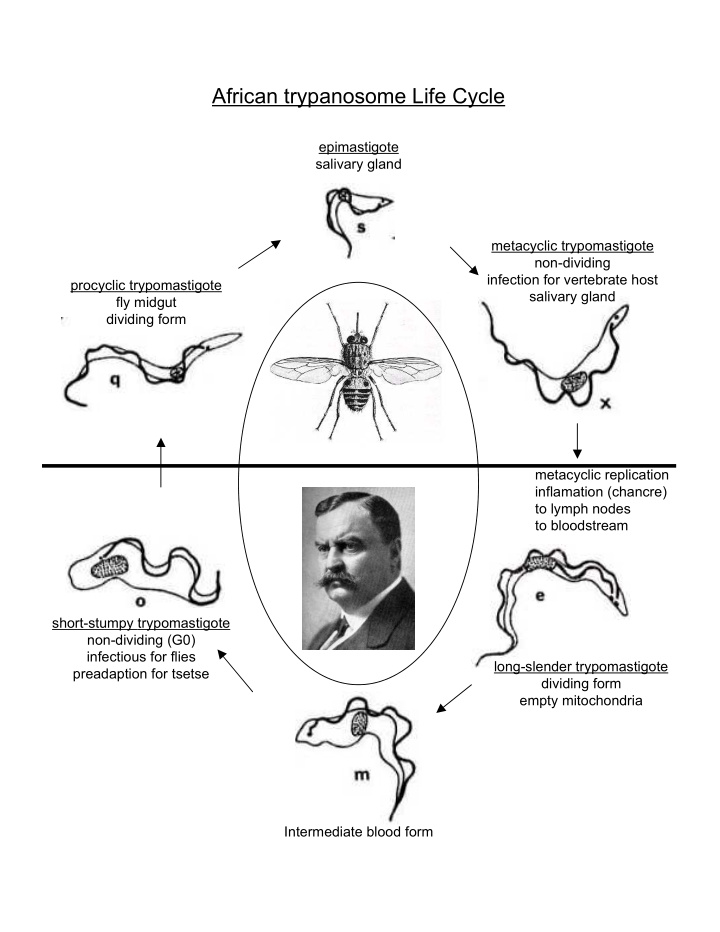



African trypanosome Life Cycle epimastigote salivary gland metacyclic trypomastigote non-dividing infection for vertebrate host procyclic trypomastigote salivary gland fly midgut dividing form metacyclic replication inflamation (chancre) to lymph nodes to bloodstream short-stumpy trypomastigote non-dividing (G0) infectious for flies long-slender trypomastigote preadaption for tsetse dividing form empty mitochondria Intermediate blood form
Stages of T. brucei Bloodstream Infection 1 2 3 4 5 Stage 1 – Long-slender trypomastigotes actively divide Stage 2 – At high cell densities, long-slenders differentiate into short-stumpys (able to differentiate further into procyclics) Stage 3 – Mostly short-stumpys, immune clearance of long- slenders Stage 4 – Immune clearance of short-stumpys Stage 5 – Next proliferation of long-slenders which can evade host immune response (How? Antigenic Variation)
Pathogenesis of African Trypanosomiasis Metacyclic Tseste bite Subcutaneous PRIMARY Itching 2-3 d Swelling 6 d Trypanosomal chancre Asymptomatic BLOOD Long slender BLOOD STAGE Short stumpy Fever, malaise, rash alternating asymptomatic Long slender flu-like symptoms LYMPHATICS Meningoencephalitis Cerebral edema CNS LATE STAGE Hemorrhage Pericarditis Coma pneumonia DEATH
Invention of DDT Widespread spraying campaign Drug treatment: Painful, expensive, and potentially ineffective
Variant Surface Glycoprotein -Episodes of relapsing parasitemias -Variant Antigenic Type -switching rate 1:10,000 to 1:1,000,000 per division -300-1000 VSG genes per tryp. -5-10% of the genome -serodemes – lineages of antigenically different tryps. w/ common ancestor -isogenic mutants – differ by the expression/function of single gene (VSG) -VSG cDNA - N-term. cleaved during membrane transport C-term. removed, GPI anchor -One VSG gene expressed per tryp., no mixing -Variation of expressed VSG is random -~20 different ES (10-20 for metacyclic VSG expression)
Leishmania major chromosome 1 gene organization: polycistronic transcription Switch •No transcriptional regulation of mRNAs •Adjacent genes are frequently not related in function • trans -splicing resolves individual mRNAs from polycistronic transcripts
Spliced Leader and the Processing of Polycistronic pre-mRNAs into discreet messages RNA Pol II m 7 G cap exon pre-mRNA intron + exon mRNA AAAAAA
Epitope Tagging Adding a sequence coding a peptide fragment that you already have Ab for.Protein C, HA, c-Myc, Strep, Flag, BB2….the list goes on and on. Phleo Phleo RNA Pol I Phleo Phleo RNA Pol I Prot C RNA Pol I Prot C Now we can easily IP and detect RNA Pol I RNA RNA wild Pol I Cell extract from: wild Pol I type tag type tag Anti-RNA pol I Anti-Protein C Immunoprecipitation Protein A binds the Fc region of Abs
Invitro trancription Lyse cells rNTPs, buffer etc. Plasmid with the Extract/purify target gene DNA Trascriptionally active fraction Extract RNA and Incubate for a while analyze Primer Extension – measures RNA quantity
The Gunzl RNA POL I experiment Immuno depletion Invitro transcription WT Prot C Prot WT C Ab binding is Ca++ dependent Primer extension Western blot to detect invitro detects the trxn RNA presence of RPA1 One of these things is not like the This shows that other… the extract is Immunodepleting the extract clear of tagged abolishes Pol I transcription Pol I (Gpeet, rRNA, VSG) but does not change Pol II transcription(SL RNA) Compare the + CA with the - CA
Progression VSG switching Early: Full genes stored generally in the minichromosomes Late: Mosaic VSG’s made from multiple recombined pieces of sub telomeric psuedo genes
Trypanosome Lytic Factor 1 High density lipoprotein complex (phospholipids, cholesterol, cholesterol ester, Apo-proteins) ApoL-1 is the lytic factor of TLF1 TLF1 complex is endocytosed by the trypanosome There is a fusion with the lysosome, swelling of lysosome, cell lysis
Serum Resistance-Associated Gene (SRA) -occurs in natural human serum (NHS) -structure similar to N-term. fold of VSG -T.brucei lacks the SRA gene – lysed in humans -addition of SRA to T.brucei confers resistance to lysis SRA SRA + NHS control control + NHS
These two columns bind ApoL-I, thus the flow through (FT) will be depleted for that protein. These depleted serums have lost lytic activity Adding Apol 1 (Apol-1 WT) back to either Apol-1 depleted serum (top box) or to FCS (bottom box) confers lytic activity to these serums a, Incubation of ETat 1.2S with differently treated NHS (SRA-ft, L61P/I62P- ft, aApoL-ft indicate flow-through fractions from SRA–, L61P/I62P SRA– and anti-apoL-I–Sepharose, respectively; aApoL-el, eluate of the fraction bound to anti-apoL-I–Sepharose). b, Incubation of ETat 1.2S in either SRA-ft or FCS supplemented with recombinant apoL-I (C-del, lacking the C-terminal 343–398 peptide) or with the equivalent fraction from control CHO cells (ctl). NHS = Normal Human Serum (lytic activity)) FCS=fetal calf serum (no lytic activity)
SRA Protein binds to apoL-1 Remember: ApoL-1 in NHS causes tryp. lysis SRA confers resistance to lysis Depletion of ApoL-1 (IP) from NHS removes lytic activity Addition of ApoL-1 to depleted serum restores lysis
Recommend
More recommend